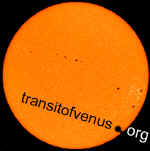[Be sure to see the Education Resources page for more observing information and links.]
http://www.transitofvenus.org/faq.htm
Frequently Asked Questions (FAQ) about the transit of Venus; when it occurs;
what you can expect to see; etc.
 http://svs-f.gsfc.nasa.gov/~wfeimer/SEC/Gen_SEC/IP/Venustrans.tif
(9 MB)
http://svs-f.gsfc.nasa.gov/~wfeimer/SEC/Gen_SEC/IP/Venustrans.tif
(9 MB)
Graphic clearly shows the duration of the transit's visibility across the United
States; from NASA - Goddard Space Flight Center Scientific Visualization
Studio. Click the URL above to view a high resolution (9 MB) version;
click the thumbnail image at left to view a low resolution (99 KB) version.
http://sunearth.gsfc.nasa.gov/eclipse/transit/TV2004.html
Pertinent data, such as sunrise times, contact times, and maps of the
visibility zone; from Fred Espenak.
http://sunearth.gsfc.nasa.gov/eclipse/transit/venus/Sun2004+2012-1.GIF
Path of Venus across the sun's disk; from Fred Espenak.
http://sunearth.gsfc.nasa.gov/eclipse/transit/venus/Map2004-1.GIF
World visibility map of transit of Venus; from Fred Espenak.
 http://sunearth.gsfc.nasa.gov/sunearthday/2004/index_vthome.htm
http://sunearth.gsfc.nasa.gov/sunearthday/2004/index_vthome.htm
Don't miss this extensive collection of Sun-Earth Day resources from the fun folks at
the Sun-Earth Connection Education Forum, including "What's Happening in
Your Area?"
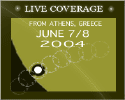 http://www.exploratorium.com/venus/index.html
http://www.exploratorium.com/venus/index.html
"Live Webcast: The Transit of Venus! Tuesday, June 8,
2004. Exploratorium will be broadcasting from Penteli Observatory just
outside of Athens, Greece. (Longitude +23.86 deg, Latitude +38.05 deg, Height
above sea level 509 m).
Webcast "explores the role of past transits in the history of astronomy and how the Venus Transit was used to calculate the distance from the Earth to the Sun, called the Astronomical Unit. The program will present cutting edge research on Sun-Venus and Sun-Earth interactions, and how NASA plans to use similar transits to detect extrasolar planets." Four telescopes with white light and H-alpha filters will capture the transit as narrators guide viewers through the event. [Exploratorium webcast info was formerly at http://www.exploratorium.edu/webcasts/.]
 http://www.vt-2004.org
http://www.vt-2004.org
The European Southern Observatory is leading an extensive program that is
loaded with information, and its website is continuously growing. This is
a thorough website for transit of Venus observers, educators, and
enthusiasts. Links to live images, TV and radio transmissions are at http://www.vt-2004.org/central/cd-links/.
![]() http://www.xs4all.nl/~carlkop/venus/transit.html
http://www.xs4all.nl/~carlkop/venus/transit.html
Large list of webcasts from across the globe, including Astronet's role from
Netherlands and Belgium.
![]() http://home.hetnet.nl/%7Esmvanroode/venustransit/eng/eng_parallax.html#BD
http://home.hetnet.nl/%7Esmvanroode/venustransit/eng/eng_parallax.html#BD
At the critical moment when observers try to time when Venus touches the
inside edge of the sun, strange phenomena such as the black
drop effect suddenly emerge. This site guides observers in discerning
at what instant internal contact occurs; from Steven van Roode.
 http://www.occultations.astronews4you.com/
http://www.occultations.astronews4you.com/
"Freeware program developed by the Dutch Occultation Association enables
you to make accurate local predictions for the transit. It also supports
both real-time and step-by-step instructions."
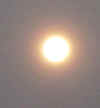 SAFETY!
SAFETY!
Overview of techniques for viewing the transit of Venus safely; describes use of
#14 shade welding glass, telescopes with solar
filters, and magnified projections. The SAFETY!
web page is recommended reading for the transit of Venus.
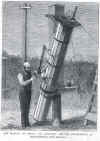 http://analyzer.depaul.edu/paperplate/Transit%20of%20Venus/Introduction.htm
http://analyzer.depaul.edu/paperplate/Transit%20of%20Venus/Introduction.htm
Introduction to the transit of Venus; from Paper Plate Education.
 blackdrop.htm
blackdrop.htm
The "Black Drop" Effect: illustrations, explanations, and enigmas.
http://sunearth.gsfc.nasa.gov/eclipse/transit/venus0412.html
Introduction, maps, and information on the visibility of the 2004 and 2012 transits of Venus;
from Fred Espenak.

United States Naval Observatory
- http://aa.usno.navy.mil/data/docs/Transit.html
Online calculator computes the local Venus transit circumstances for any location on the Earth. - http://aa.usno.navy.mil/data/docs/Venus2004.pdf
General description, geocentric data and list of ingress/egress times for major world cities (PDF)
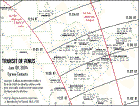 http://www.dfconcepts.com/maps/
http://www.dfconcepts.com/maps/
Venus transit plots with cities and times from Daniel Falla overlaid with
country boundary data provided by David Dunham.
 http://www.nauticoartiglio.lu.it/almanacco/trans_venus_en.htm
http://www.nauticoartiglio.lu.it/almanacco/trans_venus_en.htm
Compute the times when Venus contacts the edge of the sun for the 2004 transit
of Venus; local circumstances are shown for any given latitude and longitude;
from Franco Martinelli and the Istituto Tecnico Nautico "Artiglio" at
Viareggio, Italy.
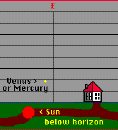 http://www.venus-transit.de/
http://www.venus-transit.de/
Applets about the transit of Venus by Jürgen Giesen
 http://people.cs.und.edu/~rmarsh/VENUS/venusindex.html
http://people.cs.und.edu/~rmarsh/VENUS/venusindex.html
The University of North Dakota will provide a webcast of the Venus transit
from India.
 http://www.lunar-occultations.com/iota/2004venus/2004venus.htm
http://www.lunar-occultations.com/iota/2004venus/2004venus.htm
General information, transit circumstances, predictions for major world cities,
maps of the path of the transit; from the International Occultation Timing
Association (IOTA).
 http://home.plex.nl/~gottm/doa/
http://home.plex.nl/~gottm/doa/
Free software to calculate the local circumstances of the June 8th Venus transit
from any location that you specify; also includes an animated view of the
transit at 1 hour, 1 min., or 1 second intervals; from Adri Gerritsen of the
Dutch Occultation Association (DOA).
 http://www.venus-transit.de/2004/venus2004.gif
http://www.venus-transit.de/2004/venus2004.gif
World map of visibility from Occult software.
 proctor2004.jpg
proctor2004.jpg
World visibility map of transit of Venus; from A Popular Account of Past and Coming
Transits, by Richard Proctor; 1882.
http://aa.usno.navy.mil/data/docs/V2004map_AA.pdf
World map of visibility for 2004 Transit of Venus (PDF); from U.S. Naval
Observatory.
 Sunrise_hour.gif
Sunrise_hour.gif
As seen from the Great Lakes region of the United States, the latter portion of the transit will
become visible at sunrise and will last less than an hour. Venus not shown
to scale here.
http://www.calsky.com/cs.cgi/Sun/7
Local circumstances for all transits of Mercury and Venus from your
site.
![]() http://www.eso.org/outreach/eduoff/vt-2004/mt-2003/mt-display.html
http://www.eso.org/outreach/eduoff/vt-2004/mt-2003/mt-display.html
Webcam to show transit updates through European Southern Observatory (ESO).
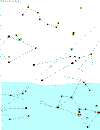 morningSKY.gif
morningSKY.gif
If you could erase the daytime sky to see the background stars on transit
morning, 2004 June 8, this chart shows what you might see. The foreground
earth appears transparent, the sky is white. Venus is near final contact;
Mercury is above the Hyades; Saturn is trailing the sun. Sun and planet
disks not to scale
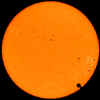 Look for the infamous “black drop" effect at
internal contacts,
when the disk of Venus (appearing entirely within the sun) just touches the edge of the sun
at ingress and egress. Near
contact a meniscus or ligament appears between the planet and the sun, and
circular Venus briefly elongates. Ultimately
reducing the accuracy of the timing, the “black drop" effect becomes the
limiting factor in determining the Astronomical Unit via transit timings.
(As noted in the Safety! page, a magnified view through
a solar filter is required to see the black drop effect.)
Look for the infamous “black drop" effect at
internal contacts,
when the disk of Venus (appearing entirely within the sun) just touches the edge of the sun
at ingress and egress. Near
contact a meniscus or ligament appears between the planet and the sun, and
circular Venus briefly elongates. Ultimately
reducing the accuracy of the timing, the “black drop" effect becomes the
limiting factor in determining the Astronomical Unit via transit timings.
(As noted in the Safety! page, a magnified view through
a solar filter is required to see the black drop effect.)
 http://www.astro.psu.edu/users/maw/transit.ppt
http://www.astro.psu.edu/users/maw/transit.ppt
Mike Weinstein provides an MSPowerPoint presentation on the transit of
Venus, with a particular slant for Chicago observers. Presentation
includes helpful animations and cites all references for images.
 http://www.eso.org/outreach/eduoff/vt-2004/index.html
http://www.eso.org/outreach/eduoff/vt-2004/index.html
A global observing program in which participants contribute data to determine
the distance from the sun to earth; from the European Southern Observatory (ESO)
and the European Association for Astronomy Education (EAAE).
 http://iss-transit.sourceforge.net/IssVenusTransit.html
http://iss-transit.sourceforge.net/IssVenusTransit.html
Trying to predict where the International Space Station (ISS) will be during
the transit of Venus, and the possibility of seeing ISS transit the sun
concurrently with Venus; from Thomas Fly.
 http://v4.livegate.net/sjkastronomy/home.html
http://v4.livegate.net/sjkastronomy/home.html
"Pictures of the transit will be displayed every minute with a resolution of 640x480;
broadcasting starts at 7.00 and ends at 13.30;"
from Sander Klieverik.
 http://home.freeuk.net/dgstrange/transit.venus.2004/
http://home.freeuk.net/dgstrange/transit.venus.2004/
Webcam with "live images added on 2004 Jun 08, approximately every 15
minutes from 05:00 to 12:00 UTC;" from Worth Hill Observatory,
Dorset, U.K.
 gallery.htm
gallery.htm
We asked photographers to send images of the sun rising in June 2003 with local
landmarks to help observers plan their site selection in 2004. Here
are a few replies from the Great Lakes region.
 http://home.cc.umanitoba.ca/~jander/transit/transitmenu.htm
http://home.cc.umanitoba.ca/~jander/transit/transitmenu.htm
Frequency of cloud cover and global weather statistics for planning trip to
observe the transit.
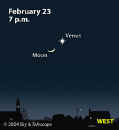 http://skyandtelescope.com/aboutsky/pressreleases/article_1178_1.asp
http://skyandtelescope.com/aboutsky/pressreleases/article_1178_1.asp
Witness the celestial dance of the planets leading up to the 2004 transit of
Venus. On February
23, 2004, Venus sizzles next to the crescent moon; from Sky &
Telescope. In late March the planets unite; June 8th Venus
passes in front of the sun.
Our Travel and Tours page now lists opportunities to witness the transit of Venus from around the world.
There you will find tours and cruises to see the transit of Venus from Iran, Turkmenistan, Turkey, Egypt, Rome, Venice, the Greek Isles, Mauritius, Africa, Siberia, Scotland, the United States, the Mediterranean, the Caribbean, and more. We list the tours only as a courtesy and do not endorse any particular tour or company.

![[ssc Radisson Diamond]](gallery/cruiseship.jpg)





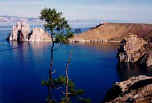


See the SAFETY! page for tips on viewing the transit of Venus safely.
